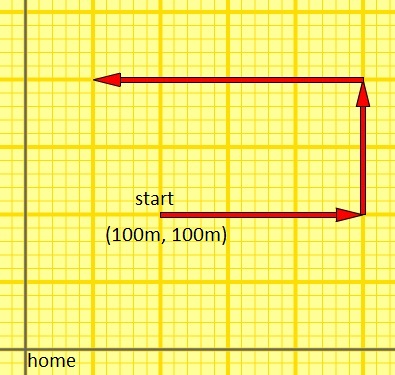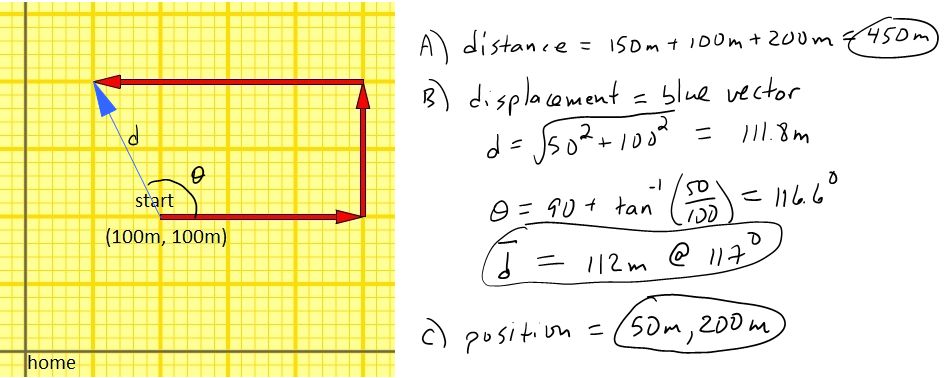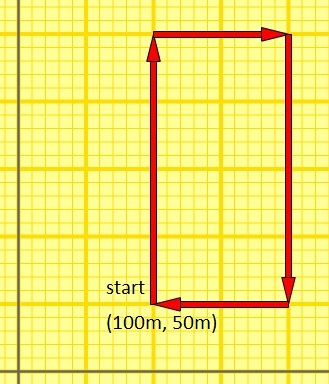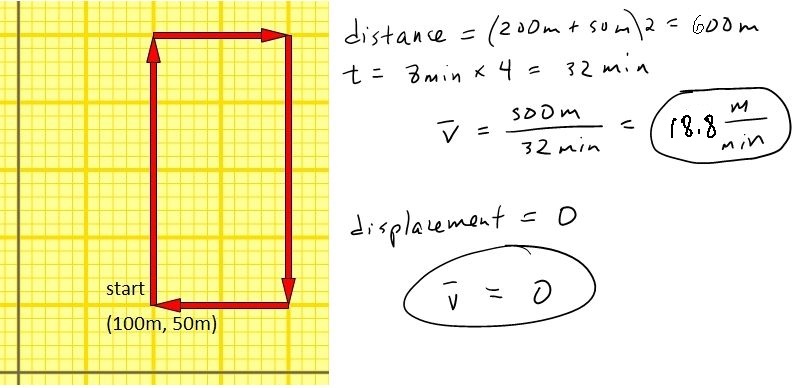Some Definitions
distance, displacement, position
Distance is a scalar. It represents the magnitude of a movement from one position to another. The odometer on your car keeps track of the distance the car has travelled, but it does not tell you where the car has been or in what direction the car has been travelling.
Displacement is a vector. It represents the magnitude and direction of a movement from one position to another, and it is independent of the path travelled between these two positions. A car moving on a circular track has the distance it travels recorded by its odometer, but if the car returns to its original position (once around the track) then its displacement will be zero.
Position is a vector. It is in fact a displacement vector given as rectangular coordiantes. It tells where something is in relation to the origin of a coordinate system.
In the Advanced Placement (AP) notation, distance, displacement and position are all denoted with the symbol x.
In the International Baccaluaureate (IB) notation, distance, displacement and position are all denoted with the symbol s.
Visit this animation to visualize the difference between distance and displacement.
Each large square in the diagram represents 50m. State . . .
A) the distance he travels
B) his displacement from his starting position
C) his final position as measured from his home.

Each large square in the diagram represents 50m. State . . .
A) the distance he travels
B) his displacement from his starting position
C) his final position as measured from his home.

instantaneous speed, average speed, instantaneous velocity, average velocity
Both the AP and the IB use the symbol v to denote all forms of speed and velocity.
Instantaneous speed is a scalar that describes the rate of change of distance at some instant in time. When you look at your speedometer on your car, it displays you how fast you are going at that instant, but it does not tell you in what direction your are going.
Average speed is also a scalar. To find the average speed of something, you must divide the total distance travelled by the time it took to cover that distance. Several possible permutations of this formula are given below.

If the acceleration (defined later) is constant between the two times, then you could also calculate average speed with this formula:

Instantaneous velocity is a vector. It is an object's speed at any given instant in time, and the direction in which it is travelling. A car's GPS can display your instantaneous velocity by giving your speed and compass heading.
Average velocity is a vector. To find the average velocity of something, you must divide the total displacement by the time it took to make that displacement. Use the same formulas as you do for average speed.
Since velocity is a vector, it needs a direction. In 1-dimensional motion (along a straight line) it is common to use + and – to state this direction. Other common terms are up, down, forward, back, and the compass directions.
B) From the diagram below, find the average speed and average velocity of Moustapha Jones as he roller skates. Each large square represents 50m. Each motion happens in 8 minutes.

An object that moves in a circular path will have some positive average speed, but will have an average velocity of zero.



Constant Speed
There are several way to represent constant speed. Examine the simulation below.
Motion Diagrams
A motion diagram is a series of images taken at regular time intervals as an object moves. If the object is moving at constant speed, then these images will be equally spaced.
Position vs. Time Graphs
Constant speed is represented by a constant slope on a position vs. time graph. Examine the list below to find how to extract information from a position vs. time graph:
- slope = velocity
- a positive slope represents a velocity in the positive direction
- a negative slope represents a velocity in the negative direction
- a horizontal slope represents a velocity of zero - the object is a rest
- a vertical slope is not possible (it always takes time to change position)
Velocity vs. Time Graphs
Constant speed is represented by a horizontal slope on a velocity vs. time graph. Examine the list below to find how to extract information from a velocity vs. time graph:
- slope = acceleration (rate of change of velocity)
- a positive slope represents a change in velocity in the positive direction
- a negative slope represents a change in velocity in the negative direction
- a horizontal slope represents a constanta velocity
- the area between the line and the time axis represents the displacement of the moving object